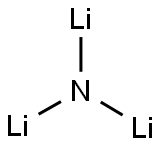| Identification | More | [Name]
LITHIUM NITRIDE | [CAS]
26134-62-3 | [Synonyms]
LITHIUM NITRIDE
Li3-N
Lithium nitride (Li3N)
lithiumnitride(li3n)
Lithium nitride (99.5% Li)
trilithium nitride
LITHIUM NITRIDE,-80 MESH
Li3N99.5%(metalsbasis)
Lithium nitride, 99.4% (metals basis)
Nitrilotrilithium
Nitrilotrislithium
Trilithionitrogen | [EINECS(EC#)]
247-475-2 | [Molecular Formula]
Li3N | [MDL Number]
MFCD00016186 | [Molecular Weight]
34.83 | [MOL File]
26134-62-3.mol |
| Hazard Information | Back Directory | [Chemical Properties]
reddish brown crystal(s) or freely flowing powder(s); slowly decomposed by atmospheric moisture; ruby red; hexagonal, a=0.3658 nm, c=0.3882nm; conductivity, 227°C, 0.04 (ohm· cm)?1; one of most effective solid ionic conductors; can be prepared by direct reaction of Li and nitrogen; used as a nitriding agent in metallurgy [HAW93] [STR93] [CIC73] [KIR81] | [General Description]
A reddish brown powder. Insoluble in most organic solvents. Used in metallurgy and chemical synthesis. | [Reactivity Profile]
LITHIUM NITRIDE is a strongly basic reducing agent. Incompatible with oxidizing agents such as atmospheric oxygen. Violently incompatible with acids, particularly oxidizing acids. Reacts violently with copper(I) chloride to produce metallic copper [Mellor, 1940, vol.8, 100]. Reacts exothermically with silicon tetrafluoride, leading to explosion [Chem. Brit., 1979, 15, 282-283]. | [Health Hazard]
Inhalation or contact with vapors, substance or decomposition products may cause severe injury or death. May produce corrosive solutions on contact with water. Fire will produce irritating, corrosive and/or toxic gases. Runoff from fire control may cause pollution. | [Fire Hazard]
Produce flammable gases on contact with water. May ignite on contact with water or moist air. Some react vigorously or explosively on contact with water. May be ignited by heat, sparks or flames. May re-ignite after fire is extinguished. Some are transported in highly flammable liquids. Runoff may create fire or explosion hazard. | [Uses]
Lithium nitride is used in metallurgy and chemical synthesis. It is also used to store hydrogen and acts as a source of the nitride ion. It is involved in the preparation of lithium hydride and lithium amide as well as a reducing agent. | [Definition]
ChEBI: Lithium nitride is a lithium salt and a nitride. | [Preparation]
Lithium nitride is prepared by the reaction of nitrogen gas with lithium metal. The
reaction may be carried out at temperatures well above the melting point of lithium metal or using solid lithium metal at temperatures even below 100°C. Lithium nitride, a
red crystalline solid, reacts with water to yield lithium hydroxide and ammonia. It is
ultimately converted to lithium carbonate in the air. The compound readily reacts with
water and carbon dioxide. It is also flammable, particularly when it is finely divided. For
these reasons lithium nitride is stored and handled under an inert atmosphere. | [Flammability and Explosibility]
Pyrophoric |
| Safety Data | Back Directory | [Hazard Codes ]
F,C | [Risk Statements ]
R11:Highly Flammable.
R14:Reacts violently with water.
R29:Contact with water liberates toxic gas.
R34:Causes burns. | [Safety Statements ]
S16:Keep away from sources of ignition-No smoking .
S22:Do not breathe dust .
S26:In case of contact with eyes, rinse immediately with plenty of water and seek medical advice .
S27:Take off immediately all contaminated clothing .
S36/37/39:Wear suitable protective clothing, gloves and eye/face protection .
S45:In case of accident or if you feel unwell, seek medical advice immediately (show label where possible) . | [RIDADR ]
UN 2806 4.3/PG 1
| [WGK Germany ]
3
| [TSCA ]
Yes | [HazardClass ]
4.3 | [PackingGroup ]
I | [Safety Profile]
A powerful reducing
agent. Upon contact with moisture, it
decomposes into lithmm hydroxide, lithium
compounds, and ammonia. The powder
may ignite spontaneously in moist air.
Flammable at elevated temperatures; ignites
and burns intensely in air. Violent reaction
with dicon tetrafluoride, copperp) chloride
+ heat. To fight fire, use dry chemical, sand,
graphite; avoid use of water or carbon
tetrachloride. When heated to
decomposition it emits very toxic fumes of
Liz0 and NOx. Used as a strong reducing
agent in organic synthesis and a solid
electrolyte in lithium batteries. See also LITHIUM COMPOUNDS and
NITRIDES. |
|
| Company Name: |
Alfa Aesar
|
| Tel: |
400-6106006 |
| Website: |
http://chemicals.thermofisher.cn |
| Company Name: |
Energy Chemical
|
| Tel: |
021-021-58432009 400-005-6266 |
| Website: |
http://www.energy-chemical.com |
| Company Name: |
Maya High Purity Chemicals
|
| Tel: |
+86 (573) 82222445 (0)18006601000 452520369 |
| Website: |
m.is0513.com/ShowSupplierProductsList15221/0.htm |
|





